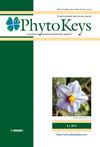Caelospermum与龙胆科(龙胆属)的腔精子:它们的词源解释。
IF 1.5
3区 生物学
Q3 PLANT SCIENCES
引用次数: 0
摘要
Caelospermum是通用名称的原始拼写,因为它出现在原型中,但在文献和在线数据库中,经常使用变体拼写Coelospermum。然而,拼写混乱是由于对词源学的误解造成的。在这里,我们证明应该保留Blume的原始拼写。本文章由计算机程序翻译,如有差异,请以英文原文为准。
Caelospermum versus Coelospermum in Rubiaceae (Gentianales): their etymologies explained.
Caelospermum is the original spelling of the generic name, as it appeared in the protologue, but in literature and online databases, the variant spelling Coelospermum is often used. However, the confusion about the spelling is caused by a misinterpretation of the etymology. Here, we demonstrate that the original spelling by Blume should be retained.
求助全文
通过发布文献求助,成功后即可免费获取论文全文。
去求助
来源期刊

PhytoKeys
PLANT SCIENCES-
CiteScore
2.60
自引率
14.30%
发文量
189
审稿时长
6 weeks
期刊介绍:
PhytoKeys is a peer-reviewed, open-access, online and print, rapidly produced journal launched to support free exchange of ideas and information in systematic botany.
All papers published in PhytoKeys can be freely copied, downloaded, printed and distributed at no charge for the reader. Authors are thus encouraged to post the pdf files of published papers on their homepages or elsewhere to expedite distribution. There is no charge for color.
 求助内容:
求助内容: 应助结果提醒方式:
应助结果提醒方式:


